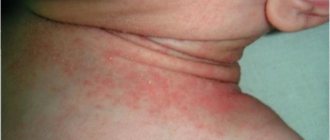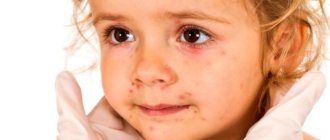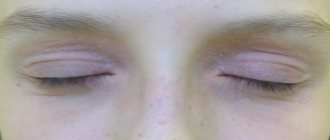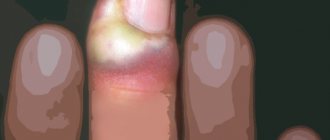And this is not at all difficult, because our skin is a litmus test for the chemical reactions occurring in the body. For example, with a cold, pimples or boils may appear on the skin, with liver disease in women, a certain pigmentation appears on the face, etc. In general, highly experienced diagnosticians who are able to tell almost everything about the patient’s state of health by looking at the iris of the eye and the skin around it.
Actually, it’s worth talking about the skin around the eyes. Usually, it is of a uniform color, one tone darker or lighter than the base color of the complexion. However, sometimes it can become thinner and red spots appear, which do not at all add a good mood to its owner.
Let's look at the most common causes of red spots around the eyes.
- Kidneys. Existing stones, kidney failure or any other problems with this organ can be reflected on the skin in the form of swelling, bags, redness or darkening (the skin around the eyes darkens).
- Lack of sleep, nervous breakdowns, stress. A simple example: a couple of days without sleep, active brain activity, tension, a lot of coffee and redness of the eyes, as well as the skin around them, is guaranteed.
- Dermatological problems. Of course, the skin around the eyes is less susceptible to skin diseases, but the occurrence of dermatitis or eczema cannot be completely ruled out. In this case, not only redness occurs, the skin may begin to peel, flake, and become crusty.
- Acute inflammation (abscess or phlegmon). The intervention of a doctor in this case is vital.
- Allergic manifestations. They are often accompanied by skin rashes, which is a reaction to exposure to an allergen: pollen, household dust, animal hair, etc.
- Congenital skin abnormalities. For example, age spots. They are often localized on the face in close proximity to the eyes.
- Unhealthy Lifestyle. Little physical activity, lack of air, poor nutrition, bad habits, etc.
Symptoms
Of course, it is simply impossible to note all the symptoms in order to make a diagnosis yourself. However, some pronounced diseases have quite memorable manifestations. So.
- Seborrheic dermatitis. It is accompanied by peeling and redness in the area under the lower eyelid, as well as under the eyebrows.
- Allergy. Its characteristic manifestation is itching, which quickly disappears after taking antihistamines.
- Sensitive skin. True, this is not a symptom, but rather a statement. It is with sensitive skin that redness around the eyes may occur due to the scorching sun, etc.
- In case of renal failure, the resulting spot does not hurt, but is slightly swollen. Moreover, such a problem is necessarily accompanied by at least a small amount of swelling.
However, this is not a complete list of symptoms that are expressed in redness of the area around the eyes.
Methods of treatment and elimination
Redness can be eliminated in different ways depending on the cause - from cosmetic camouflage to complex antibacterial treatment.
If the issue is an allergy (seasonal or to a specific substance), the allergen or a group of them is first identified.
Note! After exclusion or maximum limitation of allergens, the patient is prescribed a course of antihistamines.
These can be tablets (loratadine) or eye drops (okumetil, allergodil, cromohexal).
If bacterial ophthalmological or dermatological pathologies manifest themselves in this way , appropriate therapy is required .
For conjunctivitis, drops of ciprofloxacin, sodium sulfacyl, chloramphenicol, and albucid can be prescribed.
If the causative agent is a virus , actipol, ophthalmoferon or their analogues are used. In difficult cases, it is possible to combine several groups of drugs and add steroid, immunomodulatory and antihistamine drugs.
Blepharitis is treated not only with antibacterial drops , but also by applying ointments containing an antibiotic (tetracycline, gentamicin ointments).
Another ophthalmological disease that affects the outer part of the eyelid is stye.
This disease in most cases does not require special separate treatment.
Treatment
It is worth remembering that eliminating the cause that caused the redness will automatically eliminate the effect. Therefore, it is very important to find out the essence of the issue.
Seborrheic dermatitis is characterized by itching, peeling and focal redness of the skin. When it is caused by an allergy, the basis of therapy will be the use of antihistamines, as well as the use of corticosteroid ointments - Flucenar or Lorinden.
Abscess A very serious condition that requires immediate medical attention. In this case, you need to see a doctor as quickly as possible. An abscess is a pathological process accompanied by tissue death. Therefore, it is simply necessary to support the skin. However, the decision on adequate treatment can only be made by a doctor.
Features of the skin When red spots are a physiological feature inherent in your skin, there is nothing to worry about. Today there are many different cosmetics that will eliminate such a defect.
How to eliminate an allergic reaction to the eyes?
14.01.2021
The mucous membrane of the eye can suddenly become inflamed for various reasons. Danger may lie in wait for you at home (pet hair, dust, recent use of new medications that cause allergies ). If your eyes are red, and the skin of your eyelids begins to peel and swell, then try to strictly follow the first rule - do not scratch your eyes or touch your eyelids your hands.
All of the above signs indicate a sudden onset and progressive allergic reaction or conjunctivitis. Allergies causes , but the most common are bacteria, viruses, and chemical irritants.
You must take the following precautions.
- Avoid any contact with the source of the allergy . During the flowering season, when the air is filled with pollen, it is better to be outside less often. This also applies to the first month of summer, when poplar fluff flies everywhere.
- If you have personal transport, install a pollen filter in it. The air inside a car is much dirtier than outside. It is important to place this device in a timely manner with care for the health of the driver and passengers.
- Buy safety glasses and wear them whenever you leave the house. The main thing is to remember to constantly treat your glasses with an antiseptic and wipe them dry with a clean, dry cloth.
- Shower and rinse your eyes when you return home. There are a lot of germs and infections in public places, transport and on the street, so it is important to maintain personal hygiene.
Redness and swelling of the eyelids are perfectly relieved by special eye drops. Use them 4 times a day to relieve unpleasant symptoms.
Correct Application
- If you prefer to store the drops in the refrigerator, then before instillation you need to take them out and heat them to human body temperature.
- The eyes should be instilled from a sterile dropper or from a container with drops. Under no circumstances should the bottle come into contact with the eyes .
- Tilt your head and carefully bring the container with drops to one eye.
- Squeeze out 1 or 2 drops. Do the same procedure with the second eye.
- Apply gentle pressure to the inner corner of each eye to prevent eye drops from going into your nasopharynx.
- Close your eyes after the drops hit the mucous membrane.
As a home treatment, washing your eyes every couple of hours with chamomile or sage infusion is a good idea. also your eyes with strong tea. Compresses for each eye should be different so that the application does not transfer the infection from one area to another. Make sure you are not allergic to chamomile and sage, as many people are.
Often, in case of an allergic reaction -allergy ointment or cream is used . These remedies effectively relieve inflammation.
If you have a high fever, severe pain, or signs of illness have not gone away for 5 days, immediately contact an allergist , who will prescribe qualified medical care.
There are more severe cases when inflammation due to allergies spreads to the cornea. Dangerous discomfort can lead to blindness. Do not wait for complications and hurry up to visit a doctor for effective treatment and valuable recommendations in case of re-exacerbation of the allergic reaction .
Published in Allergology Premium Clinic
Folk remedies
In the fight for beauty, all means are good. In addition, there are a number of products that can improve the condition of the skin that are always at hand. One way that always works is masks. They make them from literally everything.
1. Potatoes. For masks, it is rubbed on a fine grater and the resulting paste is applied to the eye area using cotton swabs for 2 or 3 minutes. The healing properties of potatoes have not yet been fully studied, but the fact that it has a beneficial effect on the skin is undeniable. 2. Dill seeds. For the mask, these seeds are poured into a small fabric bag and placed in fairly hot water. Take out the bag after a few minutes, squeeze it out and apply it to your eyes for 5 minutes. 3. Herbs. Decoctions of cornflower and string are considered especially effective.
Special exercises
There are several exercises that will help you cope with mild redness caused by demodicosis, sun rays, staying in a solarium, infectious pathologies, gastrointestinal diseases or allergies. The effect is achieved through the work of facial muscles and normalization of blood circulation. The following exercises will be the most effective:
- Strong squinting of the eyes followed by widening. Repeat five times.
- Frequent blinking for 10 seconds with a break of 5 seconds. Perform 10 approaches.
- Opening your mouth wide for two seconds followed by closing it for the same amount of time. Do five approaches.
- Curl your lips into a tube and pull them forward for 5 seconds. Perform three to five approaches.
Using exercises is useful for both adults and children.
Prevention
As a rule, treatment is not required when adequate disease prevention has been established. To prevent red spots from appearing in the eye area, it is necessary to act comprehensively: make it a rule to lead a healthy lifestyle, organize yourself proper rest, as well as sleep.
It is also necessary to strengthen the body’s immune system, for which it is worth taking the necessary vitamins and minerals. Reduce mental and visual stress, walk more often. Which will lead to the disappearance of symptoms and red spots will no longer be a serious problem for you.
Red eyes: causes, treatment
Red eyes
- the main
symptom characterizing not one, but several eye diseases
.
All these diseases are diverse and have completely different causes, but they are united by one symptom - redness of the eyes. 1. What is “red eye” 2. Why are eyes red 4. Red eyes - causes 5. What to do with “red eyes” 1. What is “red eye”
In ophthalmology, the phenomenon of red eyes is called “Red Eye Syndrome”.
It includes all diseases characterized by redness. Redness of the eyes is often combined with other eye symptoms that help to correctly diagnose and carry out successful treatment: swelling of the eyelids, lacrimation, pain, blurred vision. 2.
Why are the eyes red? The redness of the eyes that we observe can only occur due to: 1. Dilation of the vessels of the conjunctiva of the sclera (white of the eye) - 97% of all causes of red eyes 2. Rupture of the vessels of the conjunctiva - 3% of red eyes In other words, if you observe If your eyes are red, it means that the blood vessels of the conjunctiva of the sclera (the whites of the eyes) are dilated or a vessel has burst and local hemorrhage has occurred in the conjunctiva.
This applies to red eyes in both adults and children. 3. Red eyes - causes
The reasons for vasodilation or rupture of a vessel are very diverse and we will try to systematize them and understand them. The main causes of vasodilation and redness of the eyes are: 1) Irritation of the eyes by external factors 2) Inflammatory process in the eyes 3) Inflammatory process in the body 4) Injury to the conjunctiva, burns 5) Increased blood pressure 6) Allergic reaction 7) Uncorrected refractive error Impaired eyelid closure during sleep The reasons that can lead to hemorrhage and redness of the eyes are limited and, first of all, these are: 9) Increased blood pressure 10) Violation of the vascular wall, atherosclerosis 11) Trauma 1) The most common cause of red eyes is
The main causes of vasodilation and redness of the eyes are: 1) Irritation of the eyes by external factors 2) Inflammatory process in the eyes 3) Inflammatory process in the body 4) Injury to the conjunctiva, burns 5) Increased blood pressure 6) Allergic reaction 7) Uncorrected refractive error Impaired eyelid closure during sleep The reasons that can lead to hemorrhage and redness of the eyes are limited and, first of all, these are: 9) Increased blood pressure 10) Violation of the vascular wall, atherosclerosis 11) Trauma 1) The most common cause of red eyes is
irritation of the conjunctiva by external factors
. It can be:
- dry indoor air, which leads to “Dry Eye Syndrome” with redness of the whites of the eyes. In such cases, patients also complain of red, dry eyes. Violation of the tear film requires its restoration; moisturizing drops, any drops of artificial tears, such as Systane, Natural Tear, Lacrisin, Lakrisifi, Khilozar-komod®, can help. It is necessary to artificially humidify indoor air in winter;
- dusty air indoors or in the city after the release of harmful substances into the atmosphere. Visine can help, but ideally you need clean air; it is recommended to use air purifiers in polluted areas;
- irritation from contact lenses. Red eyes after contact lenses indicate incorrect fitting, infection of the lens, or the fact that the cornea under the lens is suffocating and lacks oxygen from the air. This usually happens with any extended wear lenses. To get rid of red eyes after contact lenses, we recommend daily contact lenses or completely get rid of lenses using laser correction; this is the conclusion reached by everyone who has worn contact lenses for more than 15 years;
- being in a smoky room, tobacco smoke always irritates the conjunctiva. One recommendation is to avoid smoky areas;
- eye irritation from chlorine after visiting the pool
.
Very often, eyes turn red after swimming in the pool, but this is not a big deal and the redness will go away on its own in a day or two in the absence of an irritant. Vizin can speed up
the
process . Visine - constricts blood vessels and thereby reduces redness. At the same time, Visin does not in any way affect the very cause of redness of the eyes. You can also use “ To Bradex”
or “
Dexamethasone
,” which affect inflammatory mediators and speed up the process of restoring normal eye color; If redness of the eyes after the pool is accompanied by pain and blepharospasm (squinting of the eyes), then it is necessary to show the eyes to an ophthalmologist, since, in addition to the usual chlorine irritation, a burn to the cornea is possible. This happens very rarely, but it does happen.
2) Any inflammatory processes in the eye
are usually accompanied by redness of the eyes. It can be:
- conjunctivitis is viral or bacterial, the latter are distinguished, in addition to redness, by copious discharge of varying consistency. With bacterial conjunctivitis, the eyelashes stick together, especially in the morning the eyes stick together. Viral conjunctivitis can externally change only the whites of the eyes, which become red. But both are always accompanied by red eyes. First one eye turns red, then both. In addition to redness, conjunctivitis is usually accompanied by a feeling of “burning” or “sand in the eyes.” The cause of inflammatory eye redness requires antibacterial or antiviral treatment. Eye drops such as Tobradex
,
Tobrex
,
Dexamethasone
,
Levomycetin
,
Albucid
,
Levofloxacin
,
Ophthalmoferon
; - Keratitis (inflammation of the cornea) also leads to redness of the eyes and is also accompanied by severe pain when touching the eye. Treatment of red eyes due to keratitis requires treatment in an ophthalmology hospital;
- uvitis (inflammation of the choroid of the eye) and endophalmitis (inflammation of the vitreous body) are always accompanied by redness of the eyes of varying intensity. A distinctive feature of redness during inflammation of the internal membranes is a combination of redness and pain. Treatment of red eyes due to keratitis always requires treatment in an ophthalmology hospital;
3) Very often, red eyes are accompanied by local inflammatory processes outside the eye
: sinusitis (inflammation of the sinuses), sinusitis (runny nose), otitis media and even inflammatory processes in the teeth are often accompanied by “red eyes”.
This occurs due to the same blood supply to the eyes and other parts of the head, the vessels anastomose (connect) with each other and infection, for example, of teeth passes into the eye vessels, causing them to redden. A general infection in the body, viral or bacterial, accompanied by an increase in body temperature, can also cause redness of the eyes, since due to the general blood supply to the body, the infection also enters the blood vessels of the eye. Often, with general infections, we observe a red eye in combination with swelling of the eyelid, since the inflammatory process involves not only the conjunctiva, but also the eyelids, which become swollen. To treat a red eye in such cases, it is necessary to eliminate the underlying inflammatory process by a specialist. After which the redness of the eyes will disappear. If there is no secondary infection in the eye area (in the conjunctiva, uvea or cornea), separate treatment for red eyes is not required. 4) Even microtraumas
can cause redness of the eyes.
Violation of the integrity of the conjunctiva activates regeneration processes and all the cells necessary for this are sent to the wound through the vessels. The increased flow of necessary elements for regeneration causes the body to dilate blood vessels and thus we observe redness of the eyes after injury. Microtraumas can be caused by: - increased friction with hands - contact lenses - foreign body (mascara, eyelashes, etc.) entering the conjunctival cavity - glue ingestion causes redness of the eyes after the eyelash extension procedure - contact of any chemicals on the eye that can cause burns . — we observe the same phenomena after a serious blow to the eye area. 5) High blood pressure
interferes with blood flow.
Vessels throughout the body dilate to lower blood pressure. We can observe the expansion of blood vessels and capillaries before our eyes. High blood pressure is a very common cause of red eyes. Red eyes after a bath are also associated with increased blood pressure and exposure to dry air as an irritant. 6) The allergic reaction of the body
at the time of exacerbation is characterized by swelling of tissues and dilation of blood vessels, as a result of which we very often see red eyes during seasonal moments of exacerbation of allergies.
It should be noted that such redness is very difficult to differentiate from viral conjunctivitis. Red eyes after contact lenses can also be caused by an allergic reaction of the body to contact lenses. Treatment for allergic processes may involve the use of drugs containing corticosteroid hormones, such as Dexamethasone
,
Tobradex
,
Maxidex
.
7) Uncorrected refractive error
, most often with hypermetropia or presbyopia, is also often the cause of red eyes. With hypermetropia, the focus is on a long distance and everything that is closer than 5 meters is seen by a person with a strong strain of accommodation. Constant excessive tension of the accommodative muscle often leads to redness of the eyes. A similar problem arises with presbyopia, the loss of near vision with age. Full correction with glasses or laser correction relieves eye fatigue and redness; Red eyes after sleep are due to
With hypermetropia, the focus is on a long distance and everything that is closer than 5 meters is seen by a person with a strong strain of accommodation. Constant excessive tension of the accommodative muscle often leads to redness of the eyes. A similar problem arises with presbyopia, the loss of near vision with age. Full correction with glasses or laser correction relieves eye fatigue and redness; Red eyes after sleep are due to
lagophthalmos
.
Lagophthalmos is a condition when the relaxed eyelids do not close completely during sleep. A small gap remains through which the conjunctiva dries out and, as a result, redness of the eyes after sleep. Treatment must be agreed upon with a specialist; temporary improvement can be achieved with moisturizing drops at night; 9) A sharp increase in blood pressure (hypertensive crisis)
, especially with atherosclerotic changes in the blood vessels of the body, in addition to simple redness due to vasodilation,
also leads to ruptures of blood vessels
- micro-strokes in the conjunctiva. In such cases, we observe small red spots of blood, smears. Sometimes individual hemorrhages merge with each other and present a rather scary picture of blood-filled eyes around the pupil and iris. Very red eyes. Controlling your blood pressure if you have hypertension or reducing stress will help get rid of red eyes. Red eyes in such cases do not require treatment and subconjunctival hemorrhage resolves on its own without complications in 2-3 weeks.
10) Often red eyes are a sign of atherosclerosis
, when the sclerotic vascular wall cannot withstand blood pressure and ruptures even with normal intraocular pressure.
Consultation with a cardiologist is necessary; 11) Trauma
, blunt or sharp, causes rupture of the wall of the conjunctival vessels, hemorrhage and, as a result, we can observe red eyes.
In this case, drops that improve the regeneration of the conjunctiva, such as Solcoseryl and Korneregel, will help get rid of red eyes faster. 5. What to do if you have “red eyes”
The most correct option is to consult an ophthalmologist.
If this is not possible, then after reading this article you need to think about what could be the cause of “red eye” and try to eliminate this cause. Frequently asked question, red eye, what drops can help if the eye is red and the blood vessel has burst? It is possible to use drops aimed at narrowing blood vessels. The most commonly used are Vizin
and Vizin analogues -
Vizoptik
,
Tizin
.
However, you need to understand that these drops have only a temporary effect without eliminating the underlying cause that led to redness of the eyes. With prolonged use of Visine, addiction occurs to it and Visine ceases to have a therapeutic effect. If eye redness does not go away for 2 days or more, we strongly recommend that you see an ophthalmologist to find out the cause of the redness. After all, when the eye becomes red, you need to eliminate the cause of its redness, and not eliminate the effect. Red eyes should be treated by a doctor. In case of inflammatory processes, it is necessary to eliminate the infection, in case of injury, use drugs that improve the regeneration of damaged tissue - the conjunctiva, in case of refractive errors, always achieve complete correction, in case of hypertension - monitor the state of pressure, in case of a foreign body of the conjunctiva, its removal is required, red eyes after contact lenses require eye treatment and lens replacement, etc. It should be noted that hemorrhages resolve very slowly due to the small number of vessels in the scleral area. Usually, after a hemorrhage, it takes 2-3 weeks for the blood to resolve and the conjunctiva to return to its transparency and the sclera to return to its white color. Understanding how many causes of red eyes there can be, we recommend conducting an examination and taking the advice of specialists.
07/06/2021
author, Natalya Yatsinova
Our advantages
"Moscow Eye Clinic" offers comprehensive diagnostics and effective treatment of eye diseases. The use of the most modern equipment and the high professional level of specialists working in the clinic eliminate the possibility of diagnostic errors.
Based on the results of the examination, each visitor will be given recommendations on choosing the most effective methods of treating the eye pathologies identified in them. By contacting the Moscow Eye Clinic, you can be sure of quick and accurate diagnosis and effective treatment.
All questions you are interested in can be asked to specialists by calling 8 (800) 777-38-81 and 8 (499) 322-36-36 or online using the appropriate form on the website.
Mironova Irina Sergeevna
What are small hemorrhages on the skin?
Hemorrhage under the skin occurs when capillaries rupture. Due to the small amount of blood in the thinnest vessels, the spots will be within millimeters in size. Usually there is a single localization of such points. A person does not feel a deterioration in health, and may not even be aware of the presence of petechiae on the skin.
To understand that a skin rash is damage to the capillaries, and not an allergy, it is enough to press on that place - the spots do not change color and do not disappear. After some time, the formations will lighten and then disappear.
Diagnostics
To determine the cause of redness of the skin around the eyes, you need to see a doctor who will conduct several diagnostic tests.
- Anamnesis collection. The patient talks about his complaints. The skin may hurt, peel, and fester. The patient may experience itching, burning and other discomfort.
- Visual inspection. Visually, the doctor determines redness. In addition, the quality of the skin in the affected area may change (rash, peeling, swelling), and the eyeballs may be involved in the process.
- Bacteriological culture. It is performed if the bacterial nature of the disease is suspected. They take a smear from the affected area, it is better to take a piece of pus. It is inoculated on a nutrient medium in order to detect the exact pathogen and antibiotic to which it is sensitive.
- Serological method. This includes ELISA and PCR. This technique allows you to identify exactly the virus to which the patient developed a skin reaction.
- Allergy test. It is carried out in autumn or winter, when the patient's immune system is stable. To do this, a number of substances to which allergies most often occur are applied to the wrist. If a skin reaction occurs in any area, it means the patient's immune system is overreacting to the substance.
- Examination by narrow specialists. Most often, redness of the skin on the face occurs due to a disease of the epidermis, so it is recommended to consult a dermatologist.
- Treatment of systemic diseases. For example, if the pathology is caused by diabetes, you need to adjust the insulin dosage and adhere to a diet. If you have endocrine pathology, it is recommended to take an analysis of the hormonal balance in the body and correct the deficiency or excess of these substances.
After identifying the true cause of the condition, the doctor can prescribe treatment.
The most common reason for the appearance
The most common cause of hemorrhage is trauma to the skin and soft tissues.
Petechiae appear due to:
- soft tissue damage;
- pressing on clothing and its elements (straps, belts);
- rubbing the surface of the skin.
This creates high pressure, and the walls of the capillaries burst, releasing blood, which then spreads under the skin. This condition can also be caused by emotional stress, during crying or screaming. With age, all tissues of the body become less durable, so the occurrence of petechiae becomes more frequent.










